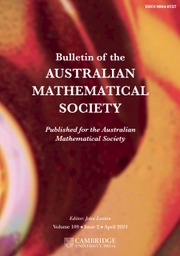No CrossRef data available.
Article contents
n-Prüfer domains
Published online by Cambridge University Press: 17 April 2009
Abstract
Core share and HTML view are not available for this content. However, as you have access to this content, a full PDF is available via the ‘Save PDF’ action button.
We introduce n-Prüfer domains which axe generalisations of Prüfer domains and give several characterisations of them in terms of generalisations of purity, flatness and absolute purity.
- Type
- Research Article
- Information
- Bulletin of the Australian Mathematical Society , Volume 68 , Issue 3 , December 2003 , pp. 423 - 430
- Copyright
- Copyright © Australian Mathematical Society 2003
References
[1]Fuchs, L. and Salce, L., Modules over valuation domains, Lecture Notes in pure and Applied Math. 97 (Marcel Dekker, New York, 1984).Google Scholar
[2]Fuchs, L. and Salce, L., Modules over non-Noetherian domains, Math. Surveys and Monographs 84 (Amer. Math. Society, Providence, R.I., 2001).Google Scholar
[3]Gilmer, R., Multiplicative ideal theory, Queens Papers Pure Appl. Math. 90 (Queens University, Kingston, ON, 1972).Google Scholar
[5]Lee, S.B., ‘Semi-Baer modules over domains’, Bull. Austral. Math. Soc. 64 (2001), 21–26.CrossRefGoogle Scholar
[6]Megibben, C., ‘Absolutely pure modules’, Proc. Amer. Math. Soc. 26 (1970), 561–566.CrossRefGoogle Scholar
[7]Rotman, J., An introduction to homological algebra (Academic Press, New York, 1979).Google Scholar
[8]Raynaud, M. and Gruson, L., ‘Critères de platitude et de projectivitè techniques de “platification” d'un module’, Invent. Math. 13 (1971), 1–89.CrossRefGoogle Scholar
[9]Sabbagh, G., ‘Coherence of polynomial rings and bounds in polynomial ideals’, J. Algebra 31 (1974), 499–507.CrossRefGoogle Scholar


